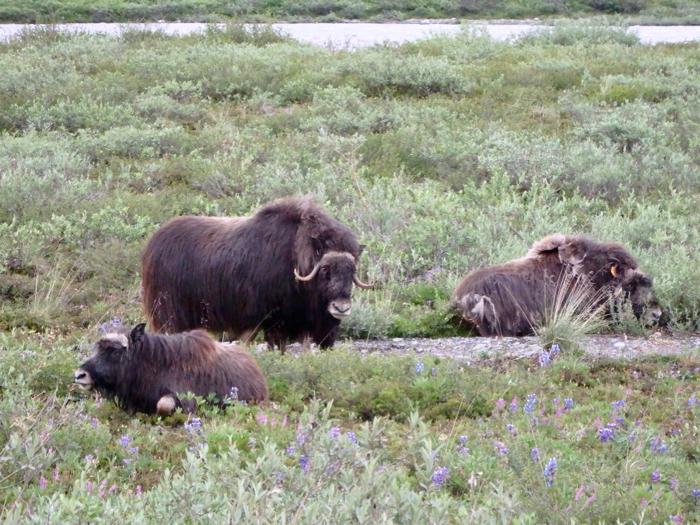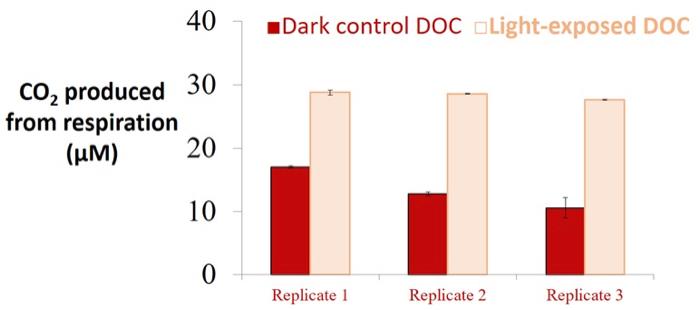Photo-Bio Part 7: Preliminary Results
Toolik Field Station, North Slope, AK
June 29, 2019
Photo of the Day:
 Muskox (Ovibos moschatus) with calves. Pump Station 3, North Slope, AK.
Muskox (Ovibos moschatus) with calves. Pump Station 3, North Slope, AK.
As a preface to this post, you’ll benefit from reading my overview of the photo-bio project. It’s important to pay attention to the key independent variables:
- Soil Type - Surface layer (organic mat) soil vs. permafrost
- Sunlight Exposure - Dark control vs. sunlight-exposed.
I am amazed by the amount of work this lab has completed over the past month. We have now finished Photo-Bio Parts 1-6 for both permafrost and surface mat soil samples. To review the steps:
- Collect soil samples from permafrost and surface mat layers (Part 1).
- Prepare crude soil leachate by adding water to the soil samples and incubating for 72 hours (Part 2).
- Filter crude soil leachate to remove particulates and microbes (Part 3).
- Exposed filtered soil leachate samples to sunlight for 24 hours (with corresponding dark controls) (Part 4).
- Inoculate soil leachate samples with bacteria from the corresponding soil type (Part 5).
- Incubate inoculated samples and sample at critical time points for analysis (Part 6).
As many of the analyses referenced in Part 6 are to take place off-site, it will be a couple of months before we obtain the formal results of this work. These results will represent a portion of Natasha Christman’s graduate thesis (Oregon State University).
In the meantime, I’d like to review results obtained from a very similar study recently conducted by this group and published in 2017.1 The experimental setup for this work, the thesis project of then graduate student Collin Ward, was nearly identical to the study we have been conducting over the past month. The major difference was that instead of wet sedge tundra, the group investigated tussock tundra, an environment at slightly higher elevation and characterized by tussock cottongrass (Eriophorum vaginatum).
Bacteria Prefer Sun-Brewed Permafrost DOC
The group analyzed CO2 produced from bacterial respiration in dark control versus light-exposed permafrost DOC leachate samples. As the below chart illustrates, in the three trials conducted, there was significantly more bacterial respiration in DOC leachate samples that had been previously exposed to sunlight. This suggests that bacteria prefer sun-brewed permafrost DOC.
 Microbes prefer to respire sun-brewed permafrost DOC to carbon dioxide, as compared to same DOC kept in the dark. As the above figure illustrates, more carbon dioxide is produced from bacterial respiration in permafrost DOC samples that have been previously exposure to sunlight. Image Source: Ward, et al., 2017.
Microbes prefer to respire sun-brewed permafrost DOC to carbon dioxide, as compared to same DOC kept in the dark. As the above figure illustrates, more carbon dioxide is produced from bacterial respiration in permafrost DOC samples that have been previously exposure to sunlight. Image Source: Ward, et al., 2017.
Photodegradation of Permafrost DOC Yields Bacterial Fuel
Using high resolution mass spectrometry, the group evaluated the compounds within permafrost DOC that bacteria are consuming, as compared to the compounds being produced via photoexposure and degraded via photoexposure. As the below Van Krevelen diagram indicates, many of the compounds produced via photoexposure are the same or similar to those being consumed by bacteria (identical or similar hydrogen/carbon and oxygen/carbon ratios). This suggests that sunlight is serving to break down DOC into organic material more easily utilized by bacteria.
 Van Krevelen diagram of compounds consumed by bacteria (yellow), produced via photoexposure (blue), and removed via photoexposure (red). Look at the overlap between blue and yellow - photodegradation of permafrost DOC produces the same compounds that bacteria are already degrading. Image Source: Ward, et al., 2017.
Van Krevelen diagram of compounds consumed by bacteria (yellow), produced via photoexposure (blue), and removed via photoexposure (red). Look at the overlap between blue and yellow - photodegradation of permafrost DOC produces the same compounds that bacteria are already degrading. Image Source: Ward, et al., 2017.
The Gist of It All
So what does this mean? Importantly, the above results strongly suggest that sunlight and bacteria are working not separately, but synergistically in the Arctic to breakdown DOC into CO2. Because bacteria prefer to respire sun-brewed DOC, even more CO2 will be released from thawing permafrost as the Arctic warms. It will be very interesting to see whether or not the data from our wet sedge tundra work over the past month supports this conclusion.
Comment below!
-
Ward, Collin P., et al. “Photochemical Alteration of Organic Carbon Draining Permafrost Soils Shifts Microbial Metabolic Pathways and Stimulates Respiration.” Nature Communications, vol. 8, no. 1, 2017. ↩︎


Add new comment